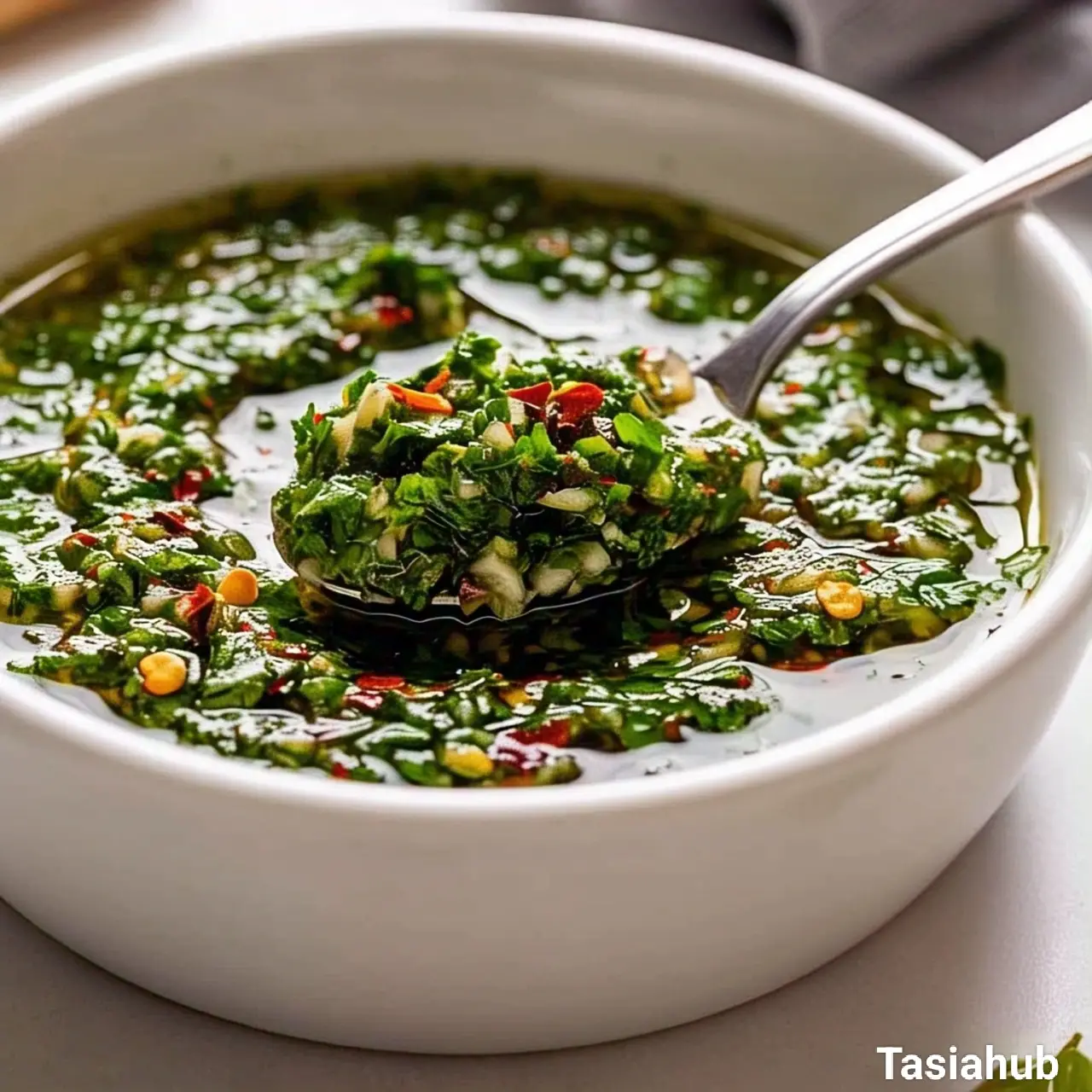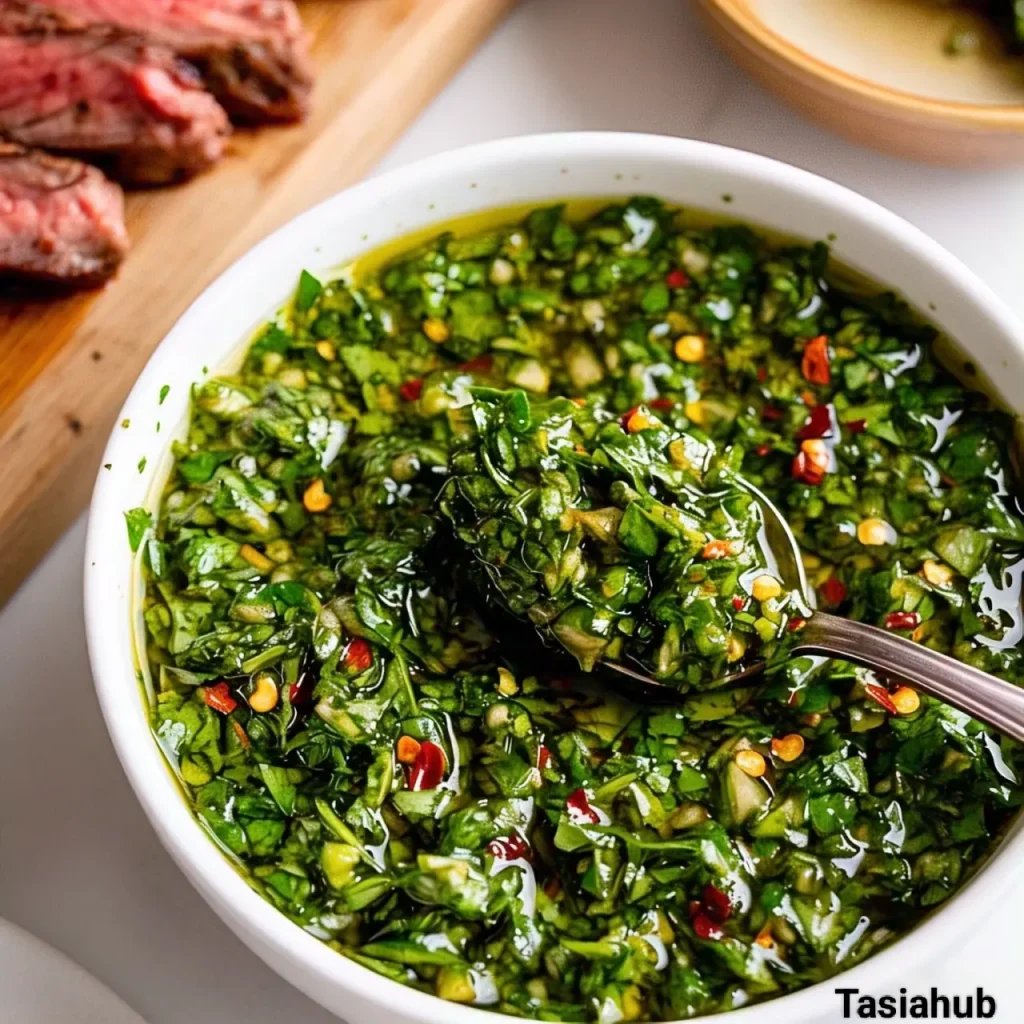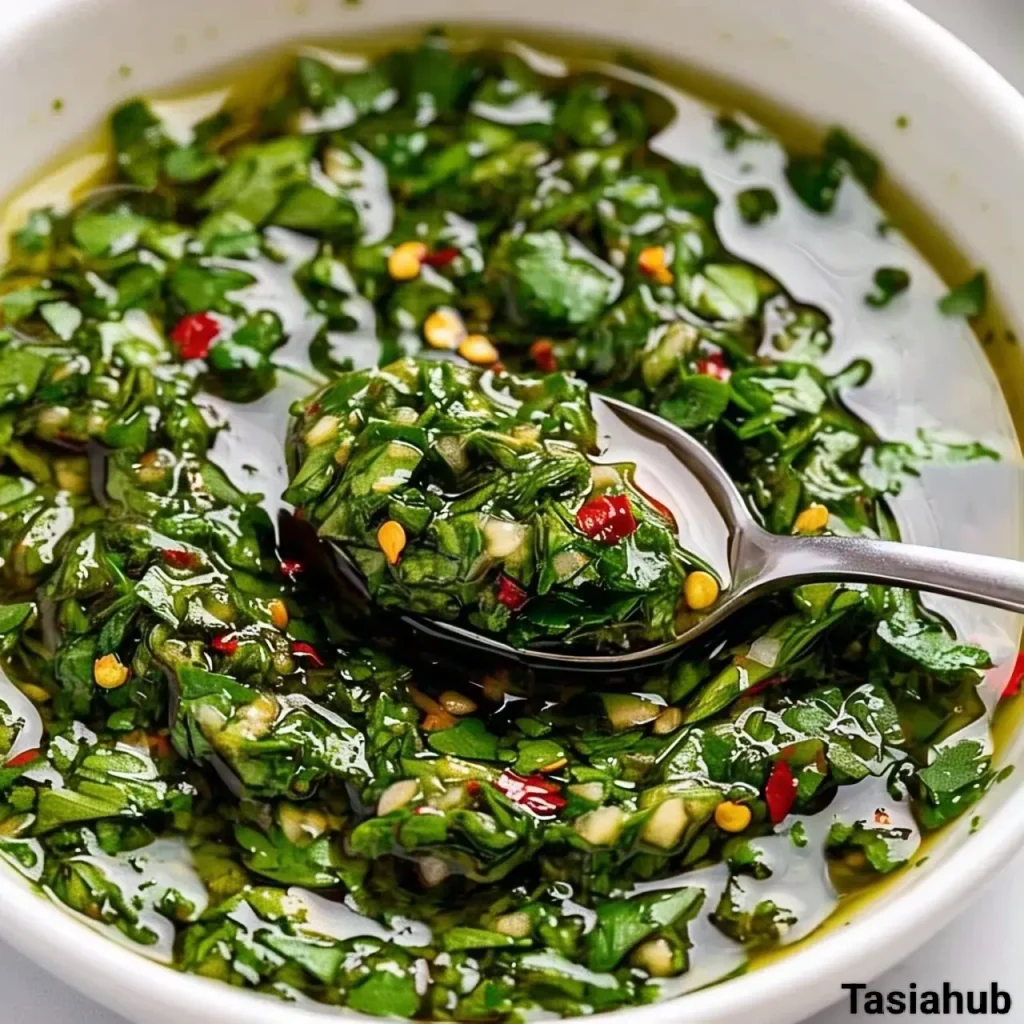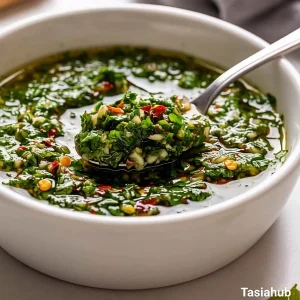Chimichurri Sauce

Have you ever tasted something that made your taste buds do a little happy dance? That’s exactly what chimichurri sauce can do! This zesty, vibrant sauce from Argentina is so easy to make and versatile that it’s becoming a favorite in kitchens everywhere.
It’s a fresh, herb-packed sauce made with parsley, garlic, vinegar, and a few other ingredients, which come together to create a deliciously tangy and herby flavor. It’s the perfect addition to grilled meats, roasted vegetables, or even just a piece of bread, and it’s a total game-changer when it comes to adding depth and excitement to your meals.
The first time I tried chimichurri was at a friend’s cookout, and I was skeptical. I’d never had anything quite like it before. But as soon as I tasted that bold, tangy flavor, I was hooked. Ever since, I’ve made it a regular part of my cooking routine, especially on those nights when I need something quick but packed with flavor.
It’s one of those sauces that’s simple enough to throw together but impressive enough to make you feel like a pro in the kitchen. Whether it’s a lazy weeknight meal or a family gathering, chimichurri always fits in perfectly.
Whether you’re grilling steak, tossing it with roasted potatoes, or even drizzling it over a salad, chimichurri adds that extra punch that elevates any dish. And because it’s made from fresh herbs, it’s bright and refreshing, which makes it perfect for summer barbecues, weeknight dinners, or even holiday feasts.
What is Chimichurri Sauce?
Chimichurri sauce is a tangy, herbaceous sauce that originated in Argentina, and it’s made from a mix of fresh parsley, garlic, vinegar, olive oil, and a few spices. It’s typically used as a marinade or topping for grilled meats like steak, chicken, or pork, but it’s so versatile you can use it on just about anything — grilled veggies, sandwiches, even pasta!
While there are other herb-based sauces like pesto, chimichurri stands out because of its vinegar base, which gives it that refreshing zing. It’s also more of a “loose” sauce, meaning it’s a bit thinner than pesto or other thicker spreads.
This makes it a great option for drizzling and marinating, and it’s easier to make in large batches. Chimichurri is also more accessible because you don’t need to worry about special ingredients like pine nuts or parmesan — just simple, fresh herbs and pantry staples.
Why You’ll Love It
- It’s super quick to make – You can whip up chimichurri in just 10 minutes! No cooking, just chop, mix, and you’re ready to go. It’s the perfect last-minute addition to any meal.
- It makes everything taste better – Whether it’s grilled chicken, steak, roasted vegetables, or even a salad, chimichurri instantly transforms any dish from good to great with its vibrant, fresh flavors.
- It’s fresh and healthy – Full of fresh herbs, olive oil, and vinegar, chimichurri is a healthy sauce that’s packed with antioxidants and good fats, so you can feel good about adding it to your meals.
- Versatility at its finest – You can use it as a marinade, a topping, or even a dipping sauce. The possibilities are endless, and you’ll find yourself using it on everything from burgers to potatoes.
- It’s a crowd-pleaser – If you’re hosting a cookout, chimichurri is guaranteed to impress your guests. It’s that one little twist that makes everything feel a little more special without a ton of effort.
Ingredient List
For the Chimichurri Sauce:
- 1 cup fresh parsley (packed)
- 4 cloves garlic, minced
- 1/4 cup red wine vinegar
- 1/2 cup extra virgin olive oil
- 1 teaspoon dried oregano
- 1/2 teaspoon red pepper flakes (adjust to taste)
- 1/2 teaspoon salt (or to taste)
- 1/4 teaspoon black pepper
For Serving:
- Your choice of grilled meat (steak, chicken, pork, etc.)
- Grilled vegetables or bread (optional, but highly recommended)
Ingredient Notes
- I always use fresh parsley for chimichurri — it’s key to getting that bright, herby flavor.
- Don’t skip the red wine vinegar! It gives the sauce its tang and balances out the richness of the olive oil.
- Extra virgin olive oil is a must for this recipe — it adds depth and richness to the sauce, so it’s worth using a good quality one.
- Red pepper flakes can be adjusted depending on how spicy you like it. Start with a little, and you can always add more later.
- For an even fresher taste, try using fresh garlic instead of pre-minced garlic — it makes a big difference in flavor!
- Salt and pepper are essential for rounding out the flavors, so don’t skip them! Adjust to your taste.
Kitchen Tools Needed
- Chef’s knife – For chopping the parsley and mincing the garlic. A sharp, reliable knife makes all the difference when prepping fresh ingredients.
- Cutting board – Essential for chopping your herbs and garlic. I love using a sturdy, large cutting board to give myself plenty of space to work.
- Mixing bowl – A medium-sized bowl to combine everything. This is where all the magic happens, so it doesn’t need to be fancy, just functional.
- Whisk or spoon – To mix all the ingredients. A small whisk works best for getting the oil and vinegar to emulsify properly.
- Measuring spoons – To get the perfect amount of salt, pepper, and red pepper flakes. It’s easy to eyeball the ingredients, but measuring helps keep the flavor balanced.
- Storage container – If you want to make extra chimichurri for later, a small glass jar or an airtight container works great for storing it in the fridge.
Instructions
Step 1: Prep the Ingredients
- Start by chopping the parsley. You’ll want to pack it into the measuring cup to get a good amount. Use a sharp chef’s knife for clean cuts, making sure to remove any tough stems.
- Mince the garlic finely. The smaller you chop it, the more flavorful your chimichurri will be!
- Measure out your red wine vinegar, olive oil, and spices so they’re ready to go.
Pro Tip: The fresher the parsley, the better! If you’re using herbs from your garden, that’s even better.
Step 2: Mix Everything Together
- In a medium-sized mixing bowl, add the parsley, minced garlic, and dried oregano.
- Pour in the red wine vinegar and olive oil.
- Season with salt, black pepper, and red pepper flakes to taste.
- Use a whisk or spoon to mix everything until it’s well combined.
Pro Tip: If you want a slightly smoother sauce, feel free to blend it briefly in a food processor. But I love the chunky texture, which gives chimichurri that rustic, homemade feel!
Step 3: Taste and Adjust
- Give your chimichurri a taste and adjust the seasoning as needed. If you want more acidity, add a little more vinegar. If you like it spicier, throw in more red pepper flakes.
- Mix again after adjusting the seasonings to make sure everything is well distributed.
Pro Tip: Sometimes, letting the chimichurri sit for 15–30 minutes before serving allows the flavors to meld together even more.
Step 4: Serve and Enjoy
- Drizzle your freshly made chimichurri over grilled meat, roasted vegetables, or even a crispy loaf of bread.
- If you’re using it as a marinade, coat your meat with the sauce and let it sit for 30 minutes to an hour before grilling.
Pro Tip: Chimichurri can be stored in the fridge for up to a week, so don’t hesitate to make a double batch! It also gets better with time as the flavors develop.

Tips and Tricks for Success
- Fresh parsley is key! I can’t stress this enough — fresh parsley really makes this sauce shine. Dried parsley just doesn’t cut it in chimichurri. If you’re using fresh herbs, go all in for the best flavor.
- Use a good-quality olive oil. Don’t skimp on the olive oil! It’s one of the main ingredients, and using a quality extra virgin olive oil will give your chimichurri a richer, smoother taste that’s worth the investment.
- Add garlic to taste. I love garlic, so I tend to be a little heavy-handed with it. But if you’re not a huge fan, start with 2 cloves instead of 4. You can always adjust based on how strong you want that garlic punch!
- Experiment with acid. If red wine vinegar isn’t your thing, try using apple cider vinegar or even lemon juice for a slightly different tang. It changes the vibe, but still keeps that bright, zesty flavor you love.
- Let it rest! Give your chimichurri time to develop flavor by letting it sit for at least 30 minutes before serving. It makes a world of difference. Trust me, the wait is worth it!
Ingredient Substitutions and Variations
- Herbs: While parsley is the classic choice, feel free to mix things up with cilantro if you’re a fan of its citrusy, fresh flavor. You can even do a 50/50 mix of parsley and cilantro for a fun twist.
- Vinegar: If you don’t have red wine vinegar, you can use white wine vinegar or apple cider vinegar. Both will still give your chimichurri that acidic bite, but with a slightly different flavor profile.
- Garlic: If you’re not into raw garlic, you can try garlic powder as a substitute. However, the fresh garlic brings the boldness that’s characteristic of chimichurri, so I recommend sticking with the fresh stuff if possible.
- Heat: For a spicier version, add a jalapeño or a little more cayenne pepper instead of red pepper flakes. You can even throw in some chipotle powder for a smoky kick.
- Add extra herbs: If you’re feeling adventurous, throw in some oregano or basil for added depth and flavor. It’s an easy way to make the sauce your own while keeping the fresh, vibrant vibe intact.
Serving Suggestions
- Grilled Steak or Chicken: Chimichurri is a classic pairing for grilled meats, especially steak or chicken. The tangy sauce cuts through the richness of the meat, making each bite so flavorful.
- Roasted Vegetables: Drizzle chimichurri over roasted vegetables like potatoes, carrots, or bell peppers. The fresh, zesty flavor of the sauce complements the earthy sweetness of the veggies.
- Sandwiches or Wraps: I love using chimichurri as a spread for sandwiches or wraps, especially with grilled chicken or roast beef. It adds a burst of flavor that makes a simple meal feel gourmet.
- Grilled Shrimp: For seafood lovers, chimichurri is an excellent topping for grilled shrimp or fish. The freshness of the herbs pairs wonderfully with the lightness of seafood.
- With Bread: For a simple but satisfying side, serve chimichurri alongside a warm, crusty loaf of bread. It’s the perfect way to scoop up every last drop of that flavorful sauce!

Storage and Reheating Instructions
- Storage: Store chimichurri in an airtight container in the fridge for up to a week. The sauce tends to get better after a day or two as the flavors meld together.
- Reheating: Chimichurri is best served fresh, but if you need to store it for a few days, no need to reheat. Just take it out of the fridge about 15 minutes before serving to allow it to come to room temperature and enhance the flavor.
- Freezing: If you want to make a large batch, chimichurri can be frozen in an airtight container for up to 3 months. Just thaw in the fridge overnight and give it a good stir before using.
- Pro Tip: If you’re making chimichurri ahead of time, try storing it in a small mason jar! It’s easy to pour, and the sealed jar keeps it fresh for longer.
Frequently Asked Questions
Can I use dried parsley instead of fresh?
It’s best to use fresh parsley for the brightest flavor, but if you’re in a pinch, you can substitute dried parsley. Just use about 1/3 of the amount, since dried herbs are more concentrated.
How spicy is chimichurri?
Chimichurri has a mild heat from the red pepper flakes, but it’s not overwhelming. You can adjust the spiciness to your taste by adding more or less red pepper flakes, or even using a fresh chili pepper for an extra kick.
Can I make chimichurri in advance?
Yes! Chimichurri gets even better after sitting for a bit. You can make it up to a day ahead and store it in the fridge. The flavors will have more time to develop, making it even more delicious.
Is chimichurri only for meat?
Not at all! While it’s traditionally paired with grilled meats, chimichurri works wonders on roasted vegetables, sandwiches, seafood, or even as a dip for bread. It’s super versatile!
How long can I store chimichurri?
Chimichurri can be stored in the fridge for up to a week. Make sure to keep it in an airtight container to preserve its freshness.
Can I use a food processor to make chimichurri?
Yes, you can use a food processor for a smoother sauce, but I love the chunky texture you get by chopping everything by hand. It adds a rustic touch to the dish!
Chimichurri sauce is an absolute game-changer when it comes to adding flavor to your meals. It’s fresh, easy to make, and oh-so-versatile. Whether you’re drizzling it over grilled meats, vegetables, or even just bread, chimichurri will instantly elevate any dish.
Did you try this recipe? Let me know in the comments how it turned out!
Don’t forget to share your photos on Instagram and tag me (@tasiahub_) or use the hashtag (#tasiahub). I’d love to see your creations!

Chimichurri Sauce
Equipment
- Chef’s knife
- Cutting board
- Mixing Bowl
- Whisk or spoon
- Measuring spoons
- Storage container
Ingredients
For the Chimichurri Sauce:
- 1 cup fresh parsley packed
- 4 cloves garlic minced
- 1/4 cup red wine vinegar
- 1/2 cup extra virgin olive oil
- 1 teaspoon dried oregano
- 1/2 teaspoon red pepper flakes adjust to taste
- 1/2 teaspoon salt or to taste
- 1/4 teaspoon black pepper
For Serving:
- Your choice of grilled meat steak, chicken, pork, etc.
- Grilled vegetables or bread optional, but highly recommended
Instructions
Step 1: Prep the Ingredients
- Start by chopping the parsley. You’ll want to pack it into the measuring cup to get a good amount. Use a sharp chef’s knife for clean cuts, making sure to remove any tough stems.
- Mince the garlic finely. The smaller you chop it, the more flavorful your chimichurri will be!
- Measure out your red wine vinegar, olive oil, and spices so they’re ready to go.
- Pro Tip: The fresher the parsley, the better! If you’re using herbs from your garden, that’s even better.
Step 2: Mix Everything Together
- In a medium-sized mixing bowl, add the parsley, minced garlic, and dried oregano.
- Pour in the red wine vinegar and olive oil.
- Season with salt, black pepper, and red pepper flakes to taste.
- Use a whisk or spoon to mix everything together until it’s well combined.
- Pro Tip: If you want a slightly smoother sauce, feel free to blend it briefly in a food processor. But I love the chunky texture, which gives chimichurri that rustic, homemade feel!
Step 3: Taste and Adjust
- Give your chimichurri a taste and adjust the seasoning as needed. If you want more acidity, add a little more vinegar. If you like it spicier, throw in more red pepper flakes.
- Mix again after adjusting the seasonings to make sure everything is well distributed.
- Pro Tip: Sometimes, letting the chimichurri sit for 15–30 minutes before serving allows the flavors to meld together even more.
Step 4: Serve and Enjoy
- Drizzle your freshly made chimichurri over grilled meat, roasted vegetables, or even a crispy loaf of bread.
- If you’re using it as a marinade, coat your meat with the sauce and let it sit for 30 minutes to an hour before grilling.
Notes
Nutritional Value (Per Serving)
- Calories: 100-120 kcal
- Fat: 10g
- Saturated Fat: 1.5g
- Monounsaturated Fat: 8g
- Carbohydrates: 3g
- Fiber: 1g
- Sugar: 1g
- Protein: 1g
- Sodium: 200-300mg (depending on salt used)
The nutritional information provided on this website is an estimate only and is intended for general guidance. We cannot guarantee its accuracy and recommend consulting a qualified healthcare professional or registered dietitian for personalized nutrition advice.